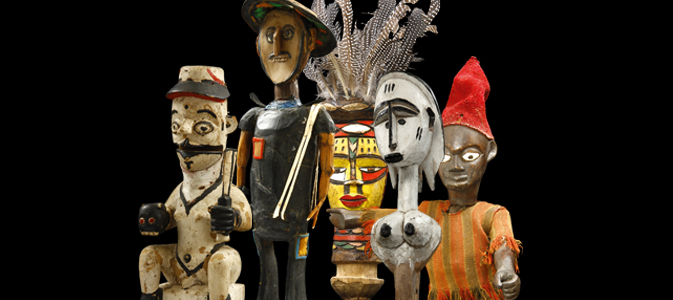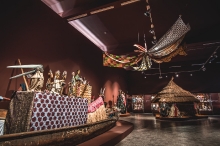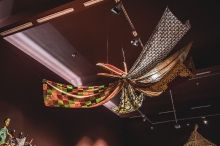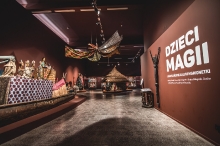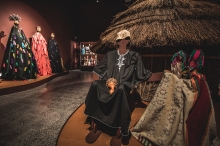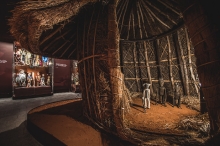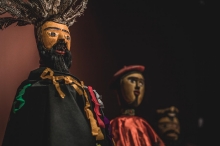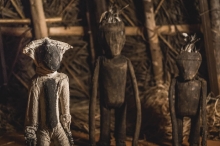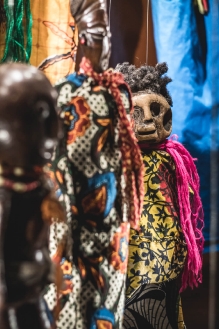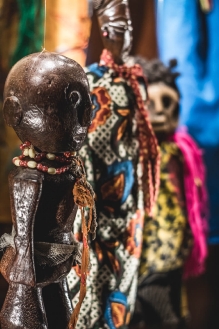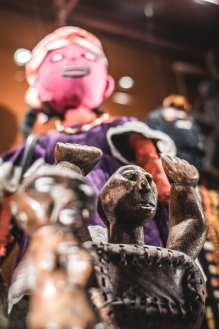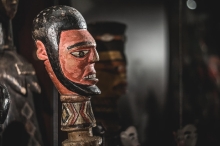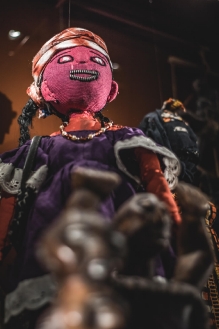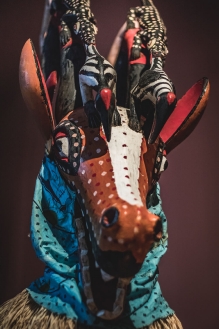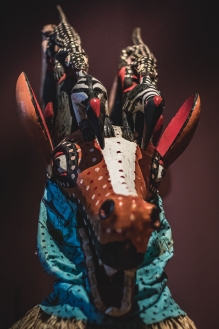The new permanent exhibition of the Department of Non-European Cultures collection is devoted to African puppet theatre – the phenomenon strongly rooted in the tradition of various African societies.
African art, discovered by Europeans over one hundred years ago by such artists like Maurice de Vlaminck, André Derain, Georges Braque, Pablo Picasso, Emil Nolde or Max Pechstein, gained full recognition. However, the colorful dolls – sometimes funny, sometimes terrifying, with moveable parts – were omitted and underestimated. It was considered that African puppet theatre was created under the influence of Europeans and it wasn’t worth of any attention and analyses. Main European museums collected also African dolls, but there was no information about their theatrical character/function. Sometimes handles were intentionally removed from some puppets due to problem with fitting them into exhibition cases. Today it’s known that puppet theatre has a long tradition in Africa which is proved by lots of archeological and historical sources and a rich oral tradition.
In the 5th century B.C. Herodotus described the feast in honor of Osiris when women were walking down the streets string-animating moving dolls with huge penises. It’s hard to find any historical sources from that era related to Black Africa, but there are many relations from later periods. In the 14th century the Arabian traveler Ibn Battuta watched puppet performances accompanying the tales of griots in the royal house in Mali. The oral tradition gives us many evidences that puppet practice is very old in Africa. There are many tales, myths or stories explaining the puppets genesis. Sometimes they come from the land of dead and one man has to sacrifice himself to explain living people this “unearthly” puppet art. Sometimes puppets roots are hidden deeply in ground, jungle or underwater – areas that mortals can’t reach. Sometimes the reason of puppet creation/appearance is woman’s infertility and will to have children, sometimes it is fraud, prophecy, a duty of giving the name to any living creature.
Dolls have various functions in African societies. They help women with infertility, provide harvest of the earth. They take part in resolving local conflicts, help to deliver a judgement, are used in divination rites and help to predict the future. Because of their abilities to become alive, puppets are constantly suspended between life and death. They can also be used just for fun. They have many forms, sizes – from really small to huge, handled by several puppeteers. They may have moveable parts moved by strings, wires, rods. They are animated by hands, toes, handling on the head, arms or keeping them in front like a shield.
The puppet theatre in Africa is completely different from that we know in Europe. Performances are mostly built of short scenes that combine dance and music and don’t have any clear dramatic form. They are often spontaneous and unpredictable.
The “Children of magic” exhibition is another – after the “In African village” and “Art of Africa – between a Mask and a Fetish” exhibitions – permanent presentation of African heritage in the National Museum in Szczecin. All of them show the multilayered panorama of daily life of chosen African societies, their ritual, ceremonial and entertainment art. Dividing the sacred and the profane spheres is never easy and clear in Africa – both constantly interpenetrate also in the exposition area.
There are about 200 African theatrical puppets on the exhibitions which origin from Mali, Niger, Nigeria, Ivory Coast, Togo, Benin, Rwanda, Tanzania, Democratic Republic of The Congo, Tunisia, Cameroon, Congo, Gabon. Some of them (Bozo and Bamana from Mali, Mbochi from Congo, Hausa from Niger and Nigeria) are presented in the performance form.
Presented objects are part of the collection given by Oleńka Darkowska-Nidzgorski and Denis Nidzgorski-Gordier – eminent experts on African puppet theatre – to the National Museum in Szczecin. She was born in 1933 in Warsaw, he – in 1934 in Argenteuil near Paris. Denis died on the 5th of September 2009 in Marseille. Oleńka and Denis met in Poland and, joined by their common passion – theatre, then puppet theatre and Africa. They both graduated from theatre studies and in 1960s moved to Paris. Oleńka Darkowska-Nidzgorski wrote her doctoral thesis titled “Théâtre populaire de marionnettes en Afrique subsaharienne” under the supervision of eminent French Africanist professor Denise Paulme-Schaeffner. In 1970s they went for the first time to Africa – to Gabon. They have been there for two years. Denis was collecting material to his doctoral thesis titled “Arts du spectacle africain: contributions du Gabon”. They fell in love with Africa and spent over a dozen years in Gabon, Benin, Togo, Rwanda and Niger (Denis has been working in those countries in French Culture Centres) and travelling to other countries looking for artists, performances and puppets. When they decided to give their collection to a museum in Poland, their choice was the National Museum in Szczecin. They appreciated the involvement in increasing knowledge and popularization of African cultures.
The collection of Oleńka Darkowska-Nidzgorski and Denis Nidzgorski-Gordier in the National Museum in Szczecin
Opening: 3.04.2016
Exhibition curator: Ewa Prądzyńska
Partners: Euroafrica Shipping Lines Ltd., Puppet Theatre Pleciuga in Szczecin
